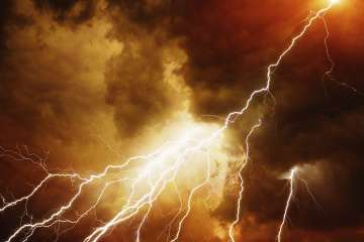UNH Physicist Finds Mysterious Anti-electron Clouds Inside Thunderstorm

Lightning and severe weather are two of the most visible products of thunderstorms. However, scientists are discovering that the storms also contain a fascinating variety of strange phenomena, including powerful gamma-ray flashes and puzzling clouds of positronsthe anti-matter version of the electron. Credit: @iStock.com/Ig0rZh.
DURHAM, N.H. - A terrifying few moments flying into the top of an active thunderstorm in a research aircraft has led to an unexpected discovery that could help explain the longstanding mystery of how lightning gets initiated inside a thunderstorm.
University of New Hampshire physicist Joseph Dwyer and lightning science colleagues from the University of California at Santa Cruz and Florida Tech describe the turbulent encounter and discovery in a paper to be published in the Journal of Plasma Physics.
In August 2009, Dwyer and colleagues were aboard a National Center for Atmospheric Research Gulfstream V when it inadvertently flew into the extremely violent thunderstorm—and, it turned out, through a large cloud of positrons, the antimatter opposite of electrons, that should not have been there.
To encounter a cloud of positrons without other associated physical phenomena such as energetic gamma-ray emissions was completely unexpected, thoroughly perplexing and contrary to currently understood physics.
"The fact that, apparently out of nowhere, the number of positrons around us suddenly increased by more than a factor of 10 and formed a cloud around the aircraft is very hard to understand. We really have no good explanation for it," says Dwyer, a lightning expert and the UNH Peter T. Paul Chair in Space Sciences at the Institute for the Study of Earth, Oceans, and Space.
It is known that thunderstorms can sometimes make flashes of energetic gamma rays, which may produce pairs of electrons and positrons when they interact with air. But the appearance of positrons should then coincide with a large increase in the number of gamma rays.
"We should have seen bright gamma-ray emissions along with the positrons," Dwyer says. "But in our observations, we first saw a positron cloud, then another positron cloud about seven kilometers away and then we saw a bright gamma-ray glow afterwards. So it's all not making a whole lot of sense."
Adds coauthor David Smith of the UC Santa Cruz, "We expected the thunderstorm to make some forms of radiation but not this. We don't even know whether it's something nature can do on its own or only happens when you toss an airplane into the mix."
The physical world is filled with normal matter and antimatter. For every normal particle there's an antiparticle, such as an electron and its associated anti-particle, called the positron, which, when brought together, annihilate each other in a flash of gamma rays. It is, Dwyer points out, the very same process that is supposed to power Star Trek's Starship Enterprise.
Having boldly gone where few people should, Dwyer says the experience inside the belly of the beast provides further insight into the bizarre and largely unknown world of thunderstorms—an alien world of gamma rays, high-energy particles accelerated to nearly the speed of light and strange clouds of antimatter positrons.
One possible explanation for the sudden appearance of positrons is that the aircraft itself dramatically influenced the electrical environment of the thunderstorm but that, Dwyer says, would be very surprising. It's also possible the researchers were detecting a kind of exotic electrical discharge inside the thunderstorm that involves positrons.
"This is the idea of 'dark lightning,' which makes a lot of positrons," says Dwyer. "In detecting the positrons, it's possible we were seeing sort of the fingerprint of dark lightning. It's possible, but none of the explanations are totally satisfying."
Dark lightning is an exotic type of electrical discharge within thunderstorms and is an alternative to normal lightning. In dark lightning, high-energy particles are accelerated and produce positrons, which help discharge the electric field.
Says Dwyer, "We really don't understand how lightning gets started very well because we don't understand the electrical environment of thunderstorms. This positron phenomenon could be telling us something new about how thunderstorms charge up and make lightning, but our finding definitely complicates things because it doesn't fit into the picture that was developing."
The University of New Hampshire, founded in 1866, is a world-class public research university with the feel of a New England liberal arts college. A land, sea, and space-grant university, UNH is the state's flagship public institution, enrolling 13,000 undergraduate and 2,500 graduate students.
Image to download: http://www.eos.unh.edu/newsimage/lightning_lg.jpg
Caption: Lightning and severe weather are two of the most visible products of thunderstorms. However, scientists are discovering that the storms also contain a fascinating variety of strange phenomena, including powerful gamma-ray flashes and puzzling clouds of positrons—the anti-matter version of the electron. Credit: @iStock.com/Ig0rZh.
Joseph Dwyer can be reached at 603-862-5408 and Joseph.Dwyer@unh.edu. For a preprint of the journal article, contact Dwyer or david.sims@unh.edu.
Latest News
-
October 30, 2024
-
October 10, 2024
-
October 8, 2024
-
October 3, 2024
-
October 1, 2024
















































